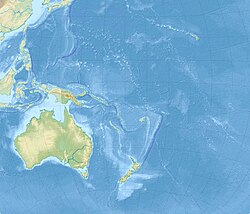2018 Fiji earthquake
 | |
 | |
| UTC time | 2018-08-19 00:19:40 |
|---|---|
| 2018-09-06 15:49:18 | |
| ISC event | 616641704 |
| 612848327 | |
| USGS-ANSS | ComCat |
| ComCat | |
| Local date | August 19 2018 |
| September 7 2018 | |
| Local time | 03:49:18 |
| 12:19:40 | |
| Magnitude | 8.2 Mww |
| 7.9 Mww | |
| Depth | 600.0 km |
| 670.8 km | |
| Epicenter | 18°28′26″S 179°21′00″E / 18.474°S 179.350°ECoordinates: 18°28′26″S 179°21′00″E / 18.474°S 179.350°E |
| Type | Normal Oblique-slip |
| Areas affected | Fiji |
| Total damage | None |
| Max. intensity | IV (Light) |
| Aftershocks | 575 (As of November 16 2018)[1] |
| Casualties | None |
The Fiji earthquakes of 2018 occurred on August 19, 2018, at 00:19:40 UTC. The epicenters were located close to the Fijian island Lakeba, and around 270 km from the small town of Levuka on Ovalau. The first earthquake registered a magnitude of 8.2 Mww and is the largest earthquake of 2018. The earthquake had a focal depth of 600 km, making it the second largest earthquake ever recorded at a depth greater than 300 km, a tie with the 1994 Bolivia earthquake, and behind the 2013 Sea of Okhotsk earthquake. Earthquakes are common in the region as the Pacific Plate is still seismically active under the Fijian Islands, even after subduction along the Kermadec–Tonga Trench. An Mww 7.9 event hit the islands again on September 6 the same year, this time at a depth of 670 km, this earthquake was a mainshock of its own. Both earthquakes may be considered a doublet event.[2]
Earthquakes[]
Deep earthquakes are commonly defined as events occurring at a depth of 300 km or greater. These earthquakes occur within subducting slabs that are descending into the mantle. As these plates bend or flex, faults break out to accommodate the deformation and along with it, occasionally producing earthquakes.[3]
August 19[]

Initially reported as an 8.0 earthquake, it was later revised by the United States Geological Survey to an 8.2.[4] Due to the earthquake being a deep-focus event, no damage was reported but it was widely felt. Small "tsunami" waves were also spotted along the coast, although it was too deep to generate more than a negligible tsunami.[5][6] More than 250 aftershocks were seen 34 days after the main event. Focal mechanism solution suggest the earthquake had a complex rupture process and fast rupture velocity of 4.1 km/s. Rupture was observed along multiple faults in a mainly north northeast striking plane for a suggested length of 102 to 152 km.[7]
September 6[]
Eighteen days after the 8.2 event, another earthquake struck closer to the island of Viti Levu. The Mww 7.9 earthquake was a downgrade from an initial magnitude of 8.1.[8][9] The earthquake had a complex combination of strike-slip and dip-slip during rupture within the slab. It was an unusual event the portion of the slab is rather aseismic. The depth of this event was slightly deeper than the first quake, and the rupture velocity was much slower, at 2.5 km/s.[7] It was suggested that coulomb stress transfer from the 8.2 quake may have triggered the 7.9 earthquake however, stress from the first quake was not sufficient to generate the next event alone. The Mww 7.9 event may have been dynamically triggered by the Mww 8.2 quake but the 18-day interval period was longer than usual as triggered quakes usually nucleate within a few hours to days.[7]
See also[]
References[]
- ^ "USGS Earthquake Catalog". United States Geological Survey.
- ^ Zhe Jia, Zhichao Shen, Zhongwen Zhan, Chenyu Li, Zhigang Peng, Michael Gurnis (October 2019). "The 2018 Fiji Mw 8.2 and 7.9 deep earthquakes: one doublet in two slabs". Earth and Planetary Science Letters.CS1 maint: multiple names: authors list (link)
- ^ Houston, Heidi (December 2015). "Deep Earthquakes". Treatise on Geophysics.
- ^ Reuters (19 Aug 2018). "Magnitude 8.2 quake strikes in the Pacific, no damage reported on Fiji". CNBC. Retrieved 4 Dec 2020.
- ^ AP (19 Aug 2018). "8.2 earthquake strikes off the coast of Fiji, small tsunami waves observed". CBS. Retrieved 4 Dec 2020.
- ^ "Earthquake of magnitude 8.2 strikes near Fiji, Tonga". Sydney Morning Herald. 19 Aug 2018. Retrieved 4 Dec 2020.
- ^ Jump up to: a b c Wenyuan, Songqiao, Dongdong, McGuire, Fan, Shawn Wei, Tian, Jeffrey (February 2019). "Complex and Diverse Rupture Processes of the 2018 Mw8.2 and Mw 7.9 Tonga-Fiji Deep Earthquakes". Geophysical Research Letters.CS1 maint: multiple names: authors list (link)
- ^ "Deep magnitude 7.8 quake hits offshore from Suva, Fiji: USGS". The Straits Times. 7 Sep 2018. Retrieved 4 Dec 2020.
- ^ NBC Staff (6 Sep 2020). "7.8M Earthquake Recorded Near Fiji". NCB San Diego. Retrieved 4 Dec 2020.
- 2018 earthquakes
- Earthquakes in Fiji
- Earthquakes in Tonga
- Doublet earthquakes
- 2018 in Fiji

